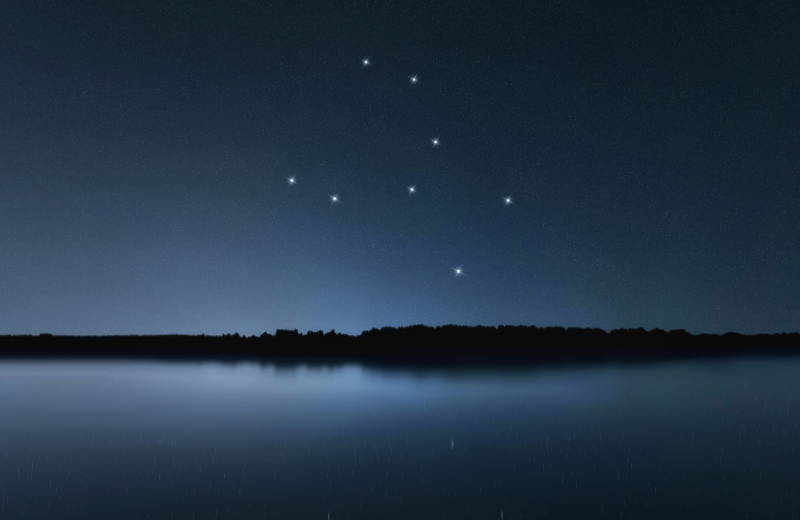Constellations, those beautiful patterns of stars, have captured human imagination for thousands of years. One such constellation is Crater, a lesser-known but fascinating group of stars with its own intriguing mythology and characteristics. This guide shares everything you need to know about the crater constellation, including how to spot it in the night sky.
Jump to:
Recommended for you!
Best SellersWhat is the Crater Constellation?
The Crater constellation is a small, cup-shaped formation located in the Southern Hemisphere of the sky. The name “Crater” comes from the Latin word for “cup” or “goblet,” perfectly describing its appearance when viewed through a telescope. It’s one of the 48 constellations listed by the ancient Greek astronomer Ptolemy and continues to be recognised as one of the 88 modern constellations.
What Does Crater Look Like?

When you observe Crater, you’ll notice that it forms a pattern resembling a goblet or a chalice. It’s made up of several faint stars, and while none of these stars are particularly bright or easy to spot without some help, the constellation itself stands out once you understand its shape. Crater isn’t the easiest constellation to pick out if you’re in an area with significant light pollution, but on a clear night in the right conditions, you can trace its cup-like outline in the sky.
How Far is the Crater Constellation from Earth?
The stars in the Crater constellation vary in distance, but most of them are several hundred light-years away from Earth. For example, the brightest star, Delta Crateris, is about 195 light-years away.
The Crater Constellation Myth

The Crater constellation is closely associated with the Greek myth of Apollo, the god of the Sun, and a cunning bird. The story goes that Apollo asked a crow to fetch water for a sacrificial ceremony. However, the crow became distracted and, instead of completing the task, delayed its return.
To cover up its negligence, the crow returned with a snake and claimed that the snake had blocked its path to the water. Apollo, not fooled by the crow's excuses, cursed it and placed both the crow and the goblet in the sky. He also included the snake, represented by the constellation Hydra, as a reminder of the crow’s trickery. This story explains the close proximity of Crater to the constellations Corvus (the crow) and Hydra.
Crater’s Stars
Crater may not be among the most prominent constellations, but it does boast some noteworthy stars:
- Delta Crateris: The brightest star in Crater, Delta Crateris is a giant orange star with a magnitude of 3.56. Though not particularly luminous compared to stars in more famous constellations, it plays a crucial role in outlining Crater’s distinctive cup shape. Located about 195 light-years from Earth, Delta Crateris stands out as the primary reference point when observing this constellation.
- Alpha Crateris (Alkes): Another significant star in Crater is Alpha Crateris, also known as Alkes, which means "the cup" in Arabic. It has a magnitude of 4.08, making it fainter but equally important in defining the constellation’s shape. Alkes lies around 174 light-years away from Earth and adds to Crater’s unique celestial character.
Nebulae in the Crater Constellation

While Crater isn’t particularly known for having many nebulae or deep-sky objects, it does lie near several interesting galaxies that are worth exploring. One such galaxy is NGC 3887, a spiral galaxy located around 60 million light-years away.
Finding Crater in the Sky
Crater is best observed in the month of April when it becomes most visible in the Southern Hemisphere's autumn skies. From the Northern Hemisphere, you can catch Crater just above the southern horizon during spring, making this the ideal time for viewing.
Locating Crater
Finding Crater is relatively simple once you’ve identified the neighbouring constellations Corvus and Hydra. Here’s how to locate it:
- Identify Hydra: Hydra, the largest constellation in the sky, is an excellent reference point. It stretches out across the heavens, and Crater sits directly above a section of Hydra’s elongated form.
- Look for Corvus: Corvus, the small but bright constellation representing a crow, lies near Crater. Once you’ve pinpointed Corvus, Crater should be just to the east, forming a cup-like shape between Corvus and Hydra.
Using Tools to Spot Crater
Stargazing apps and sky maps can be incredibly helpful, especially for beginners or those viewing in areas with light pollution. These tools can outline Crater’s shape and make locating it easier on nights when the sky is crowded with stars, or visibility is low.
Viewing Crater with Binoculars or a Telescope
- With Binoculars: Binoculars can help highlight the stars of Crater, making them appear more distinct. This can be especially useful if you’re in a light-polluted area where the fainter stars are difficult to see.
- With a Telescope: To fully appreciate Crater’s stars and nearby galaxies, a telescope is ideal. While Crater’s stars are relatively dim, a telescope can provide a clearer view and bring out some of the lesser-known celestial features around the constellation.
Best Viewing Conditions
For the best stargazing experience, head to a dark location away from city lights. A moonless night will give you the darkest skies, allowing Crater’s faint stars to shine through more vividly. Patience and a keen eye will help you enjoy the charm of this unique constellation.
Recommended for you!
Best SellersFun Facts About Crater
- Crater’s History: Crater has been known since antiquity and was catalogued by Ptolemy in the 2nd century.
- Constellation Family: It belongs to the Hercules family of constellations, a group of 19 constellations that are loosely related based on their location in the sky.
- Size and Position: Crater is the 53rd largest constellation, occupying an area of 282 square degrees.
- Cultural References: The constellation’s association with water and cups is a recurring theme in many mythologies, often symbolising the cycle of life, nourishment, and divine offerings.
Study Astronomy for £29
If the Crater constellation has sparked your curiosity, why not explore more about the stars and the cosmos with our Astronomy Diploma Course at Centre of Excellence? This course offers a detailed understanding of the universe, from constellations and star types to the fundamentals of space observation. Perfect for all budding astronomers, the course is available for a discounted price of £29.













